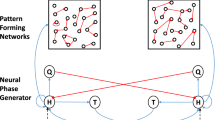Abstract
This paper presents the results of a computer simulation which, combined a small network of spiking neurons with linear quadratic regulator (LQR) control to solve the acrobot swing-up and balance task. To our knowledge, this task has not been previously solved with spiking neural networks. Input to the network was drawn from the state of the acrobot, and output was torque, either directly applied to the actuated joint, or via the switching of an LQR controller designed for balance. The neural network’s weights were tuned using a (μ + λ)-evolution strategy without recombination, and neurons’ parameters, were chosen to roughly approximate biological neurons.






Similar content being viewed by others
References
Anderson, Moore (1971) Linear optimal control. Prentice Hall, Englewood Cliffs
Beyer H-S (2001) The theory of evolution strategies. Springer, Heidelberg
Boone G (1997) Minimum-time control of the acrobot. In: Proceedings of IEEE international conference on robotics and automation, vol 4, pp 3281–3287
Coulom R (2004) High-accuracy value-function approximation with neural networks applied to the acrobot. European Symposium on Artificial Neural Networks
Federici D (2005) Evolving developing spiking neural networks. In: The IEEE congress on evolutionary computation, vol 1, pp 543–550
Dario Floreano, Yann Epars, Jean-Christophe Zufferey, Claudio Mattiussi (2006) Evolution of spiking neural circuits in autonomous mobile robots: Research articles. Int J Intell Syst 21(9):1005–1024
French RLB, Damper RI (2002) Evolution of a circuit of spiking neurons for phototaxis in a Braitenberg vehicle. In: ICSAB: proceedings of the seventh international conference on simulation of adaptive behavior on From animals to animats. MIT Press, Cambridge, pp 335–344
Gerstner W (2001) Pulsed neural networks, Chap. 1: Spiking neurons, pp 3–53. In: Maass and Bishop [15]
Gerstner W, Werner M.K (2002) Spiking neuron models: single neurons, populations, plasticity. Formal spiking neuron models, Chap. 4. Cambridge University Press, Cambridge
Joshi P, Maass W (2005) Movement generation with circuits of spiking neurons. Neural Comput 17(8):1715–1738
Kandel ER, Schwartz JH, Jessell TM (2000) Principles of neural science, 4th edn. McGraw-Hill, New York
Kawada K, Fujisawa S, Obika M, Yamamoto T (2005) Creating swing-up patterns of an acrobot using evolutionary computation. Proceedings of IEEE international symposium on computational intelligence in robotics and automation, CIRA 2005, pp 261–266
Lai X, She JH, Ohyama Y, Cai Z (1999) Fuzzy control strategy for acrobots combining model-free andmodel-based control. IEE Proc Control Theory Appl 146(6):505–510
Maass W (1997) Networks of spiking neurons: the third generation of neural network models. Neural Netw 10(9):1659–1671
Maass W, Bishop CM (eds) (2001) Pulsed neural networks. MIT Press, Cambridge
Markram H (2006) The blue brain project. Nat Rev Neurosci 7(2):153–160
Nam TK, Fukuhara Y, Mita T, Yamakita M (2002) Swing-up control and avoiding singular problem of an acrobot system. In: Proceedings of the 41st SICE annual conference, SICE 2002
Press WH, Teukolsky ST, Vetterling WT, Flannery BP (2002) Numerical recipes in C: the art of scientific computing, Chap. 16.1, 2nd edn. Cambridge University Press, Cambridge, pp 710–714
Spong MW (1995) The swing up control problem for the acrobot. IEEE Control Syst Magaz 15(1):49–55
Xu X, He H (2002) Residual-gradient-based neural reinforcement learning for the optimal control of an acrobot. In: Proceedings of the 2002 IEEE international symposium on intelligent control, pp 758–763
Yoshimoto J, Nishimura M, Tokita Y, Ishii S (2005) Acrobot control by learning the switching of multiple controllers. Artif Life Robot 9(2):67–71
Acknowledgments
Funding for this research has been supplied in part by the University of Newcastle Research Scholarship (UNRS) and by The ARC Centre for Complex Dynamic Systems and Control (CDSC). We would also like to thank Maria Seron for helpful discussions.
Author information
Authors and Affiliations
Corresponding author
Rights and permissions
About this article
Cite this article
Wiklendt, L., Chalup, S. & Middleton, R. A small spiking neural network with LQR control applied to the acrobot. Neural Comput & Applic 18, 369–375 (2009). https://doi.org/10.1007/s00521-008-0187-1
Received:
Accepted:
Published:
Issue Date:
DOI: https://doi.org/10.1007/s00521-008-0187-1




